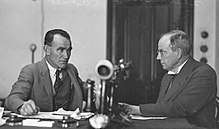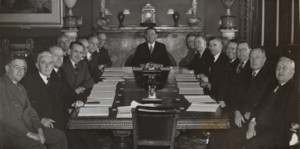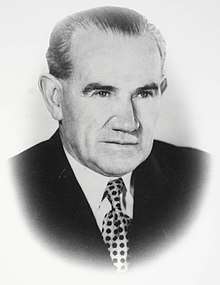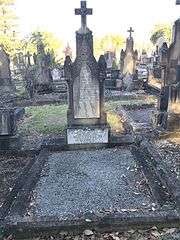Joseph Cahill
| The Honourable Joseph Cahill | |
|---|---|
 | |
| 29th Premier of New South Wales Elections: 1953, 1956, 1959 | |
|
In office 2 April 1952 – 22 October 1959 | |
| Monarch | Elizabeth II |
| Governor |
Sir John Northcott Sir Eric Woodward |
| Deputy | Bob Heffron |
| Preceded by | James McGirr |
| Succeeded by | Bob Heffron |
| 3rd Deputy Premier of New South Wales | |
|
In office 21 September 1949 – 2 April 1952 | |
| Premier | James McGirr |
| Preceded by | Jack Baddeley |
| Succeeded by | Robert Heffron |
| Minister for Local Government | |
|
In office 8 June 1944 – 2 April 1952 | |
| Premier |
William McKell James McGirr |
| Preceded by | James McGirr |
| Succeeded by | Jack Renshaw |
| Member of the New South Wales Parliament for Cook's River | |
|
In office 10 May 1941 – 22 October 1959 | |
| Preceded by | New district |
| Succeeded by | Tom Cahill |
| Personal details | |
| Born |
21 January 1891 Redfern, Colony of New South Wales |
| Died |
22 October 1959 (aged 68) Sydney, New South Wales, Australia |
| Resting place | Rookwood Cemetery |
| Political party | Australian Labor Party (New South Wales Branch) |
| Spouse(s) |
Esmey Mary Kelly (m. 1922–1959; his death) |
| Children |
Tom Cahill John Cahill |
John Joseph Cahill (21 January 1891 – 22 October 1959), also known as Joe Cahill or J. J. Cahill, was a long-serving New South Wales politician, railway worker, trade unionist and Labor Party Premier of New South Wales from 1952 to his death in 1959. Born the son of Irish migrants in Redfern, New South Wales, Cahill worked for the New South Wales Government Railways from the age of 16 before joining the Australian Labor Party. Being a prominent unionist organiser, including being dismissed for his role in the 1917 general strike, Cahill was eventually elected to the Parliament of New South Wales for St George in 1925.
After many years of backbench service, including a term outside of parliament, Cahill was eventually appointed Secretary for Public Works in 1941 and Minister for Local Government in the government of William McKell in 1944, where he led significant reforms of local government in the state, including establishing a Royal commission in 1945, and passing the landmark Local Government (Areas) Act of 1948. Promoted to Deputy Premier in 1949, Cahill became Premier of New South Wales from April 1952 to his death in October 1959. His term as premier is primarily remembered for his government's role in post-war infrastructure development, which included the commissioning of the Sydney Opera House and construction of the expressway which now bears his name.
Early years
Joe Cahill, as he was popularly known, was born on 21 January 1891 in the inner-Sydney suburb of Redfern, the son of Irish-born parents, Thomas Cahill, and Ellen Glynn. Cahill's father was a labourer at the nearby Eveleigh Railway Workshops. After being educated at St Brigid's convent school, Marrickville, and Patrician Brothers' School, Redfern, at age 16 he was apprenticed as a fitter for the New South Wales Government Railways at the Eveleigh railway workshops on 2 July 1907.[1]
As a member of the Workers' Educational Association and the Marrickville branch of the Amalgamated Society of Engineers (known from 1921 as the Amalgamated Engineering Union [AEU]), Cahill became politically active and joined the NSW Branch of the Labor Party. Like most Roman Catholics within the Labor Party he opposed conscription for the First World War in 1916, and lost his railway job on 14 August 1917 after taking part in a general strike over railway workers' pay and conditions.[1]
Cahill also made his first attempt to enter politics as a member of the Parliament of New South Wales, when he stood as the Labor candidate for the Legislative Assembly seat of Dulwich Hill at the March 1917 election. Bearing the marks of a young radical, Cahill campaigned on big ideas like the abolition of the Legislative Council and replacing the state Governor with the Lieutenant-Governor, but his comment that "the wealth of the country should be placed in one big pool" attracted amusement in the press.[2][3][4] Cahill was subsequently defeated on a margin of 31-68% against the sitting Nationalist Party member, Tom Hoskins.[5]
On 17 February 1918 his younger brother who also worked in the New South Wales railways, Sapper Thomas James Cahill, of the 4th Field Company (4th Division), Australian Engineers, was killed in action in France.[6][7] After a period of difficult unemployment, Cahill found some work selling insurance amongst other temporary jobs, but was re-employed by the New South Wales Government Railways in mid-1922 at the Randwick Tramway Workshops.[8][9]
On 11 November 1922, at St Brigid's Church, Marrickville, he married Esmey Mary Kelly and they were to have three sons and two daughters. When their first son was born on 12 February 1924, they named him "Thomas James" after Cahill's younger brother.[10] In 1922, after taking part in an unsuccessful attempt to unseat the Engineers Union's NSW governing body through a federal council, Cahill among several others was sued by the union for "illegally holding office within the union".[11] Although the suit was later dismissed by the Chief Judge in Equity, Philip Street, Cahill was banned from holding office in the union by the AEU until 1925.[1][12][13]
Early political career

Eight years after his first tilt at state politics, Cahill was elected as one of the members of the NSW Legislative Assembly seat of St George at the 1925 state election, which swept the Labor party into government under Jack Lang.[14][15] He was never counted among the close allies of Lang, and remained on the backbench throughout Lang's two terms in government. Cahill, along with half of the parliamentary caucus, supported Peter Loughlin, when he challenged Lang for the party leadership in September 1926.[1] With the abolition of St George in 1930, Cahill ran for Arncliffe and was appointed party whip.[16][8] However, Cahill lost his bid to be re-elected for Arncliffe to United Australia Party's Horace Harper, at the 1932 election, with the electoral tide sweeping out the dismissed Lang Labor government.[17]
This defeat, nevertheless, proved to be only a temporary setback, and Cahill found work as a shop inspector for a shoe retailer in the interim. Retaining his interest in political matters, Cahill remained loyal to party leader Jack Lang, exclaiming to an Arncliffe Labor meeting: "Mr. Lang is the greatest friend the workers have ever had, and time will prove that Lang is Right."[18] In 1935, Cahill was returned to parliament in Arncliffe for the State Labor Party despite the overall defeat at the election, declaring that while "the Press had poisoned the minds of the people, [...] ten years after he was dead the Press would proclaim Mr. Lang as the greatest hero Australia had seen for many a long day."[19][20]
With Lang's leadership in doubt after a further election loss in 1938, Cahill's praise of Lang soured and he supported a caucus motion to support federal intervention in the state branch's factional infighting which had led to several of his colleagues defecting to the Member for Botany, Bob Heffron's Industrial Labor Party.[21][22][23] Cahill subsequently supported William McKell, when he successfully challenged Lang for the Labor Party leadership in September 1939, and was elected to the party executive.[24]

A frequent speaker in the assembly, Cahill often spoke on railway matters and lobbied the government unsuccessfully for an extension of the Cooks River Tram Line to Arncliffe.[25][26][27] The Labor party swept back into office at the 1941 election and William McKell became the new Premier, who then appointed Cahill as Secretary of Public Works.[28] When Arncliffe was abolished in 1941, he switched to the new electorate of Cook's River.[29]
Minister of the Crown

In 1944 Cahill became Minister for Local Government, a position he would hold for eight years; he used this position to augment local governments' powers. He established the State Dockyard at Newcastle and the State Brickworks at Homebush Bay. In addition, he supervised the establishment of the Electricity Commission of New South Wales, which brought electricity to much of rural New South Wales, and the Cumberland County Council, which developed the landmark county planning scheme in 1948.[1]
In September 1949, the serving Deputy Premier, Jack Baddeley, announced his retirement from parliament and his appointment as Director of the State Coal Mines Control Board, and Cahill stood to succeed him as deputy.[30][31][32] At the caucus meeting on 21 September, Cahill was elected Deputy Premier 21 votes to 20 against Attorney General Clarrie Martin.[33][34]
Premier of New South Wales
When James McGirr announced his resignation as premier on the grounds of ill health on 1 April 1952, Cahill, a natural successor as deputy, put himself forward as a candidate to succeed him against, among others, Minister for Education, Bob Heffron.[35] However, the day before the ballot on 3 April, Heffron had been made aware that he would not have the numbers in caucus to win against Cahill and consequently made arrangements with Cahill to give the votes of his bloc to him, in exchange for his support to become Cahill's Deputy Premier. As a result, on 3 April Cahill defeated Attorney General Clarrie Martin 32 votes to 14 to become Premier and Heffron defeated Mines Secretary Joshua Arthur 32 votes to 14 to become Deputy Premier.[36][37][38]
He won the state elections of 1953, 1956, and 1959. In November 1958, he officially opened the Wangi Power Station on Lake Macquarie.[39]
Sydney Opera House
It was in November 1954 that Cahill first began to champion the idea of an opera house in Sydney on the site of the old Fort Macquarie Tram Depot at Bennelong Point, announcing an international competition for its design in September 1955, which was subsequently won by Danish Architect, Jørn Utzon in January 1957.[40] In August 1957, Cahill responded to criticisms that the opera house was an extravagance and inaccessible to the ordinary public by noting that, "the building when erected will be available for the use of every citizen, that the average working family will be able to afford to go there just as well as people in more favourable economic circumstances, that there will be nothing savouring even remotely of a class conscious barrier and that the Opera House will, in fact, be a monument to democratic nationhood in its fullest sense."[41]
On 5 February 1959, Cahill signed the contract for the first stage of building works for the Opera House with the Chairman of Lendlease Corporation and Civil & Civic, Dick Dusseldorp, and the managing director of Brederos, Jan de Vries.[42] On the occasion of the official start of building and the laying of the foundation plaque on 2 March 1959, Cahill declared that the Sydney Opera House, "will stand not merely as an outstanding example of modern architecture or even as a world famous opera house, but as a shrine in which the great artists of the world may be seen and heard and our own artists may display the flowering of Australian culture."[41]
Sectarian tensions
Cahill's political skills, his determination to avoid another Lang-style split in the party, and his government's, and indeed personal, close alliance with Sydney's Catholic Archbishop, Cardinal Norman Gilroy, ensured that Labor in New South Wales avoided the devastating divisions which forced the party out of office in Victoria, Western Australia, and Queensland during the 1950s split.[43]
Illness and death in office
A heavy smoker, Cahill suffered increasingly poor health during 1959, with Deputy Premier Bob Heffron often acting in Cahill's place during these times. He died at Sydney Hospital of a myocardial infarction in October of that year and Heffron succeeded him unopposed in the premiership.[44] No premier of New South Wales before him had continuously remained in power as long as Cahill did and no later premier would manage to surpass the length of Cahill's tenure until Robert Askin in 1972.
Honours and legacy

Survived by his wife, Esmey, daughters Gemma and Margaret, and sons Tom, John and Brian, Cahill was granted a state funeral and was laid-in-state at St Mary's Cathedral, Sydney.[44][45] His funeral at the cathedral was attended by over 3000 people, including Governor Sir Eric Woodward, Prime Minister Robert Menzies and Opposition Leader H V Evatt, and it was estimated that around 200,000 people lined the route from the catherdral to his burial place at Rookwood Cemetery. In his panegyric, Cardinal Norman Gilroy praised Cahill as a "man of immaculate integrity".[46]
His eldest son, Thomas James Cahill, was elected to his father's vacated seat of Cook's River at the subsequent December by-election and served as an MP until 1983.[10] His second son and namesake, John Joseph Cahill, served as a judge of the Industrial Commission of New South Wales from 1971–1998.[47]
Over the years Cahill was given several awards. He received an honorary Doctor of Laws (LL.D.) from the University of Sydney in 1952, an honorary Doctor of Science (D.Sc.) from the New South Wales University of Technology in 1955, and an honorary Doctor of Literature (D.Litt.) from the University of New England in 1956.[48][49][50] On 17 December 1958, the City of Sydney decided to name the new highway across Circular Quay as the "Cahill Expressway", and Cahill was present when the Blue Mountains City Council officially named the "Cahills Lookout" in Katoomba on 6 June 1959.[51][52] In 1961 the Municipality of Rockdale in his former electorate decided to name the new park in Wolli Creek as "Cahill Park".[53]
Following Cahill's death, the new public high school in Mascot in his former seat of Cook's River also decided to honour his memory, as well as his role in the school's establishment, by naming themselves the "J J Cahill Memorial High School", which was officially opened by his widow, Esmey Cahill, on 24 March 1961. On the school's 50th anniversary, the principal Robyn Cowin noted that Cahill "was a man of genuine personal integrity, a family man and a great worker whose deeds spoke for themselves [...] His code of behaviour and indeed the manner of his life embodied the school motto 'Do what is right because it is right'".[54][55]
References
- 1 2 3 4 5 Clune, David. "Cahill, John Joseph (Joe) (1891 - 1959)". Australian Dictionary of Biography. Australian National University. Retrieved 8 February 2010.
- ↑ "DULWICH HILL". The Sydney Morning Herald (24, 703). New South Wales, Australia. 9 March 1917. p. 8. Retrieved 30 March 2018 – via National Library of Australia.
- ↑ "Sam Square's Budget". Goulburn Evening Penny Post. New South Wales, Australia. 17 March 1917. p. 2 (EVENING). Retrieved 30 March 2018 – via National Library of Australia.
- ↑ "SOME SPLASH". The St George Call. XIV (11). New South Wales, Australia. 17 March 1917. p. 6. Retrieved 30 March 2018 – via National Library of Australia.
- ↑ Green, Antony. "NSW Elections – Dulwich Hill 1917". NSW Elections Index. Parliament of New South Wales. Archived from the original on 26 August 2015. Retrieved 2018-03-30.
- ↑ "Thomas James Cahill". Discovering ANZACs. National Archives of Australia. Retrieved 30 March 2018.
- ↑ "Thomas James Cahill". Roll of Honour. Australian War Memorial. Retrieved 30 March 2018.
- 1 2 "Mr John Joseph Cahill (1891 - 1959)". Former Members. Parliament of New South Wales.
- ↑ "Old Smoothie - John Joseph Cahill". Eveleigh Stories. Australian Technology Park Heritage. Retrieved 30 March 2018.
- 1 2 "Mr Thomas James CAHILL (1924 - 1983)". Former Members. Parliament of New South Wales. Retrieved 30 March 2018.
- ↑ "THE AMALGAMATED ENGINEERS". The Daily Telegraph (13, 584). New South Wales, Australia. 23 November 1922. p. 8. Retrieved 30 March 2018 – via National Library of Australia.
- ↑ "IN EQUITY". The Sydney Morning Herald (26, 485). New South Wales, Australia. 23 November 1922. p. 6. Retrieved 30 March 2018 – via National Library of Australia.
- ↑ "A.E.U. SUPPORT". The Labor Daily (403). New South Wales, Australia. 7 May 1925. p. 8. Retrieved 30 March 2018 – via National Library of Australia.
- ↑ "Mr. J. J.Cahill, Labor Candidate St. George". Freeman's Journal. LXXV. New South Wales, Australia. 28 May 1925. p. 19. Retrieved 30 March 2018 – via National Library of Australia.
- ↑ Green, Antony. "NSW Elections – St George 1925". NSW Elections Index. Parliament of New South Wales. Archived from the original on 26 August 2015. Retrieved 2018-03-30.
- ↑ Green, Antony. "NSW Elections – Arncliffe 1930". NSW Elections Index. Parliament of New South Wales. Archived from the original on 26 August 2015. Retrieved 2018-03-30.
- ↑ Green, Antony. "NSW Elections – Arncliffe 1932". NSW Elections Index. Parliament of New South Wales. Archived from the original on 26 August 2015. Retrieved 2018-03-30.
- ↑ "EX-M.L.A. & WIFE ARE HONORED". The Labor Daily (2702). New South Wales, Australia. 2 August 1932. p. 7. Retrieved 30 March 2018 – via National Library of Australia.
- ↑ "ARNCLIFFE". The Sydney Morning Herald (30, 381). New South Wales, Australia. 18 May 1935. p. 15. Retrieved 30 March 2018 – via National Library of Australia.
- ↑ Green, Antony. "NSW Elections – Arncliffe 1935". NSW Elections Index. Parliament of New South Wales. Archived from the original on 26 August 2015. Retrieved 2018-03-30.
- ↑ "MR. LANG DEFEATED IN CAUSUS". The Cessnock Eagle And South Maitland Recorder. 27 (2619). New South Wales, Australia. 28 April 1939. p. 7. Retrieved 30 March 2018 – via National Library of Australia.
- ↑ "DISCORD AT ARNCLIFFE". The Sydney Morning Herald (31, 622). New South Wales, Australia. 8 May 1939. p. 11. Retrieved 30 March 2018 – via National Library of Australia.
- ↑ "WILD SCENES AT ARNCLIFFE". National Advocate. New South Wales, Australia. 8 May 1939. p. 2. Retrieved 30 March 2018 – via National Library of Australia.
- ↑ "DEFEAT OF MR. LANG". The Sydney Morning Herald (31, 726). New South Wales, Australia. 6 September 1939. p. 15. Retrieved 30 March 2018 – via National Library of Australia.
- ↑ "OUR TRANSPORT". The St George Call. XXXII (40). New South Wales, Australia. 4 October 1935. p. 2. Retrieved 30 March 2018 – via National Library of Australia.
- ↑ "COOK'S RIVER TRAMS". The Propeller. XXIX (1471). New South Wales, Australia. 18 May 1939. p. 3. Retrieved 30 March 2018 – via National Library of Australia.
- ↑ "COOK'S RIVER TRAMS". The Propeller. XXIX (1474). New South Wales, Australia. 8 June 1939. p. 2. Retrieved 30 March 2018 – via National Library of Australia.
- ↑ "LABOR CABINET IS SWORN IN". Newcastle Morning Herald And Miners' Advocate (20, 157). New South Wales, Australia. 17 May 1941. p. 7. Retrieved 30 March 2018 – via National Library of Australia.
- ↑ Green, Antony. "NSW Elections – Cook's River 1941". NSW Elections Index. Parliament of New South Wales. Archived from the original on 26 August 2015. Retrieved 2018-03-30.
- ↑ "Baddeley To Be Coal Director". The Sydney Morning Herald (34, 855). New South Wales, Australia. 7 September 1949. p. 3. Retrieved 6 April 2018 – via National Library of Australia.
- ↑ "Mr. Baddeley Resigns Seat". The Sydney Morning Herald (34, 857). New South Wales, Australia. 9 September 1949. p. 4. Retrieved 6 April 2018 – via National Library of Australia.
- ↑ "Baddeley's Successor; Poll To-day". The Sydney Morning Herald (34, 861). New South Wales, Australia. 14 September 1949. p. 3. Retrieved 6 April 2018 – via National Library of Australia.
- ↑ "Cahill Deputy Premier: Other Cabinet Changes". The Sydney Morning Herald (34, 868). New South Wales, Australia. 22 September 1949. p. 3. Retrieved 6 April 2018 – via National Library of Australia.
- ↑ "VICE-REGAL". The Sydney Morning Herald (34, 868). New South Wales, Australia. 22 September 1949. p. 2. Retrieved 6 April 2018 – via National Library of Australia.
- ↑ "5 MAY CONTEST PREMIERSHIP – Labour Leader Chosen To-day". Newcastle Morning Herald and Miners' Advocate. NSW. 2 April 1952. p. 1. Retrieved 21 April 2014 – via National Library of Australia.
- ↑ "CAHILL BECOMES PREMIER. Wins Ballot By 32 To 14". The Sydney Morning Herald. 3 April 1952. p. 1. Retrieved 21 April 2014 – via National Library of Australia.
- ↑ "New Premier's Rise From Labour Ranks". The Sydney Morning Herald (35, 657). New South Wales, Australia. 3 April 1952. p. 2. Retrieved 30 March 2018 – via National Library of Australia.
- ↑ "THE NEW PREMIER". The Propeller. XLII, (2141). New South Wales, Australia. 10 April 1952. p. 1. Retrieved 30 March 2018 – via National Library of Australia.
- ↑ "Premier J.J. Cahill, Lake Macquarie Power Station opening, Wangi, 7 November 1958". Lake Macquarie City Library. City of Lake Macquarie. Retrieved 30 March 2018.
- ↑ "Sydney Opera House Guide". NSW State Archives and Records. Missing or empty
|url=(help);|access-date=requires|url=(help) - 1 2 "Sydney Opera House, Bennelong Point, March 2nd, 1959" (PDF). NSW State Archives & Records. NSW Government Printer. 2 March 1959. Retrieved 31 March 2018.
- ↑ McQuillan, Ern, 1926- (1959), New South Wales Premier Mr Joseph Cahill signs the contract for the building of the Sydney Opera House observed by Mr Jan de Vries and Mr Gerardus Jozef Dusseldorp, 1959 [picture] / Ern McQuillan
- ↑ P. Golding, They called him Old Smoothie: John Joseph Cahill, Journal of the Australian Catholic Historical Society 31/2 (2010/11), 75-82.
- 1 2 "HIGH TRIBUTES PAID TO MR. CAHILL". The Canberra Times. 34, (9, 428). Australian Capital Territory, Australia. 23 October 1959. p. 1. Retrieved 30 March 2018 – via National Library of Australia.
- ↑ "MR. HEFFRON SWORN IN AS PREMIER". The Canberra Times. 34, (9, 429). Australian Capital Territory, Australia. 24 October 1959. p. 1. Retrieved 30 March 2018 – via National Library of Australia.
- ↑ "FUNERAL SERVICE FOR MR. CAHILL". The Canberra Times. 34, (9, 430). Australian Capital Territory, Australia. 26 October 1959. p. 1. Retrieved 30 March 2018 – via National Library of Australia.
- ↑ McGinness, Mark (22 September 2006). "Obituary - Jurist with a steely reputation: John Cahill, 1926-2006". The Sydney Morning Herald. Retrieved 30 March 2018.
- ↑ "Honorary awards - The Honourable John Joseph Cahill". Archives and Records Management Services. University of Sydney. Retrieved 30 March 2018.
- ↑ "Honorary Degree and Fellowship holders". UNSW Sydney. University of New South Wales. Retrieved 4 April 2018.
- ↑ "Honorary Degree Recipients since 1955 and Emeritus Professor Awardees since 1964". UNE Council. University of New England. Retrieved 4 April 2018.
- ↑ "THE COUNCIL OF THE CITY OF SYDNEY.—Local". Government Gazette Of The State Of New South Wales (3). New South Wales, Australia. 9 January 1959. p. 99. Retrieved 27 March 2018 – via National Library of Australia.
- ↑ "K062 : Cahills Lookout". Heritage search. NSW Office of Environment and Heritage. Retrieved 3 April 2018.
- ↑ Beichert, Kahlia (1 December 2015). "Long wait for upgrade: Cahill Park improvements may take 15 years". St George and Sutherland Shire Leader. Retrieved 3 April 2018.
- ↑ "Sydney school honours Irish Australian namesake". Irish Echo. 11 April 2011. Archived from the original on 12 April 2011. Retrieved 30 March 2018.
- ↑ "Our School History". J J Cahill Memorial High School. Retrieved 2011-10-04.
Further reading
- Golding, Peter S (2009), They Called Him old Smoothie: John Joseph Cahill, North Melbourne, Victoria: Australian Scholarly Publishing, ISBN 978-1-921509-53-7
- David Clune (2006). "16. CAHILL, John Joseph". In Clune, David; Turner, Ken. The Premiers of New South Wales 1856-2005: Volume 2, 1901-2005. Sydney: The Federation Press. pp. 295–314. ISBN 1-86287-551-0.